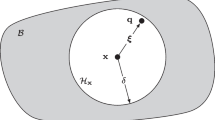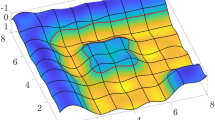Abstract
Smoothed particle hydrodynamics (SPH) method is a powerful tool for modeling solid mechanics problems, especially for large deformation problems. However, it suffers from boundary deficiency and difficulty of boundary condition treatment. In this work, a normalized SPH method is proposed to overcome these problems. The method is based on a newly developed normalized particle approximation. To derive this particle approximation, a normalized kernel approximation which is accurate for derivatives of linear functions everywhere in a problem domain is constructed, and all integral terms of the normalized kernel approximation including boundary terms are discretized by particle summations. The normalized particle approximation is free of matrix inversion, consequently attractive in computational stability and simplicity compared with other corrective particle approximations. Its approximation accuracy is demonstrated by calculating derivatives of test functions. Based on this particle approximation, the formulation of the normalized SPH method for transient solid mechanics problems is derived. Moreover, a direct method of treating traction boundary conditions is presented by making use of the boundary term of the normalized particle approximation. The accuracy and capability of the normalized SPH method are validated by the calculation of elastic wave propagation in solids and compared with commonly used SPH method.















Similar content being viewed by others
References
Gingold RA, Monaghan JJ (1977) Smoothed particle hydrodynamics: theory and application to non-spherical stars. Mon Not R Astron Soc 181(3):375–389
Lucy LB (1977) A numerical approach to the testing of the fission hypothesis. Astrono J 82:1013–1024
Xiao YH, Dong HH (2017) Studying normal and oblique perforation of steel plates with SPH simulations. Int J Appl Mech 9(6):1750091
Xiao YH, Dong HH, Zhou JM, Wang JG (2017) Studying normal perforation of monolithic and layered steel targets by conical projectiles with SPH simulation and analytical method. Eng Anal Bound Elem 75:12–20
Zhang ZL, Liu MB (2017) Smoothed particle hydrodynamics with kernel gradient correction for modeling high velocity impact in two- and three-dimensional spaces. Eng Anal Bound Elem 83:141–157
Zhang ZL, Feng DL, Ma T, Liu MB (2019) Predicting the damage on a target plate produced by hypervelocity impact using a decoupled finite particle method. Eng Anal Bound Elem 98:110–125
Xu XY, Deng XL (2016) An improved weakly compressible SPH method for simulating free surface flows of viscous and viscoelastic fluids. Comput Phys Commun 201:43–62
Guo XH, Rogers BD, Lind S, Stansby PK (2018) New massively parallel scheme for incompressible smoothed particle hydrodynamics (ISPH) for highly nonlinear and distorted flow. Comput Phys Commun 233:16–28
Krimi A, Rezoug M, Khelladi S, Nogueira X, Deligant M, Ramírez L (2018) Smoothed particle hydrodynamics: a consistent model for interfacial multiphase fluid flow simulations. J Comput Phys 358:53–87
Hu DA, Long T, Xiao YH, Han X, Gu YT (2014) Fluid–structure interaction analysis by coupled FE-SPH model based on a novel searching algorithm. Comput Methods Appl Mech Eng 276:266–286
Verbrugghe T, Domínguez JM, Crespo AJC, Altomare C, Stratigaki V, Troch P, Kortenhaus A (2018) Coupling methodology for smoothed particle hydrodynamics modelling of non-linear wave-structure interactions. Coast Eng 138:184–198
Zhang NB, Zheng X, Ma QW, Duan WY, Khayyer A, Lv XP, Shao SD (2018) A hybrid stabilization technique for simulating water wave-structure interaction by incompressible smoothed particle hydrodynamics (ISPH) method. J Hydro-environ Res 18:77–94
Ye T, Pan DY, Huang C, Liu MB (2019) Smoothed particle hydrodynamics (SPH) for complex fluid flows: recent developments in methodology and applications. Phys Fluids 31:011301
Liu WK, Jun S, Zhang YF (1995) Reproducing kernel particle methods. Int J Numer Methods Fluids 20:1081–1106
Randles PW, Libersky LD (1996) Smoothed particle hydrodynamics: some recent improvements and applications. Comput Methods Appl Mech Eng 139(1–4):375–408
Chen JK, Beraun JE, Jih CJ (1999) An improvement for tensile instability in smoothed particle hydrodynamics. Comput Mech 23(4):279–287
Zhang GM, Batra RC (2004) Modified smoothed particle hydrodynamics method and its application to transient problems. Comput Mech 34(2):137–146
Batra RC, Zhang GM (2008) SSPH basis functions for meshless methods, and comparison of solutions with strong and weak formulations. Comput Mech 41(4):527–545
Liu MB, Xie WP, Liu GR (2005) Modeling incompressible flows using a finite particle method. Appl Math Model 29(12):1252–1270
Huang C, Lei JM, Liu MB, Peng XY (2015) A kernel gradient free (KGF) SPH method. Int J Numer Methods Fluids 78(11):691–707
Johnson GR, Beissel SR (1996) Normalized smoothed functions for SPH impact computations. Int J Numer Methods Eng 39(16):2725–2741
Zhang ZL, Liu MB (2018) A decoupled finite particle method for modeling incompressible flows with free surfaces. Appl Math Model 60:606–633
Wang J, Wu H, Gu CS, Hua H (2013) Simulating frictional contact in smoothed particle hydrodynamics. Sci China Technol Sci 56(7):1779–1789
Wang J, Hua H, Gu CS (2014) On the correction of the boundary deficiency in SPH for the frictional contact simulation. Sci China Technol Sci 57(1):86–100
Belytschko T, Krongauz Y, Dolbow J, Gerlach C (1998) On the completeness of meshfree particle methods. Int J Numer Methods Eng 43(5):785–819
Shepard D (1968) A two-dimensional interpolation function for irregularly-spaced data. In: Proceedings of the 1968 ACM national conference, New York, pp 517–524
Seo S, Min O (2006) Axisymmetric SPH simulation of elasto-plastic contact in the low velocity impact. Comput Phys Commun 175(9):583–603
Seo S, Min O, Lee J (2008) Application of an improved contact algorithm for penetration analysis in SPH. Int J Impact Eng 35(6):578–588
Edelsbrunner H, Kirkpatrick D, Seidel R (2009) On the shape of a set of points in the plane. IEEE Trans Inf Theory 29(4):551–559
Edelsbrunner H, Mücke EP (1994) Three-dimensional alpha shapes. ACM Trans Gr 13(1):43–72
Franci A, Cremonesi M (2017) On the effect of standard PFEM remeshing on volume conservation in free-surface fluid flow problems. Comput Part Mech 4(3):331–343
Cerquaglia ML, Deliége G, Boman R, Papeleux L, Ponthot JP (2017) The particle finite element method for the numerical simulation of bird strike. Int J Impact Eng 109:1–13
Johnson GR, Stryk RA, Beissel SR (1996) SPH for high velocity impact computations. Comput Methods Appl Mech Eng 139(1):347–373
Acknowledgements
Support from National Natural Science Foundation of China (Grant No.: 11862005) and Natural Science Foundation of Jiangxi Province of China (Grant No.: 20181BAB211012) is gratefully acknowledged.
Author information
Authors and Affiliations
Corresponding author
Ethics declarations
Conflict of interest
On behalf of all authors, the corresponding author states that there is no conflict of interest.
Additional information
Publisher's Note
Springer Nature remains neutral with regard to jurisdictional claims in published maps and institutional affiliations.
Rights and permissions
About this article
Cite this article
Xiao, Y., Hong, X. & Tang, Z. Normalized SPH without boundary deficiency and its application to transient solid mechanics problems. Meccanica 55, 2263–2283 (2020). https://doi.org/10.1007/s11012-020-01255-6
Received:
Accepted:
Published:
Issue Date:
DOI: https://doi.org/10.1007/s11012-020-01255-6




